Fuel Tank Replacement 4 Door Utility/Pickup
Draining Procedure
Caution: Gasoline or gasoline vapors are highly flammable. A fire could occur
if an ignition source is present. Never drain or store gasoline or diesel
fuel in an open container, due to the possibility of fire or explosion. Have
a dry chemical (Class B) fire extinguisher nearby.
Caution: Unless directed otherwise, the ignition and start switch must be in the OFF or LOCK position, and all electrical loads must be OFF before servicing
any electrical component. Disconnect the negative battery cable to prevent an electrical spark should a tool or equipment come in contact with an exposed electrical terminal. Failure to follow these precautions may result in personal injury and/or damage to
the vehicle or its components.
- Disconnect the negative
battery cable.
- Use a hand operated pump device in order to remove the fuel through
the filler neck.
If the pump is equipped, make sure to hook up the static ground wire
to a metal part of the gas tank before you begin.
Removal Procedure
- Raise the vehicle. Refer to
Notice: When jacking or lifting a vehicle, do not allow the lift pads to contact any
of the following parts:
| • | The catalytic converter |
| • | The transmission shift cables |
in General Information.
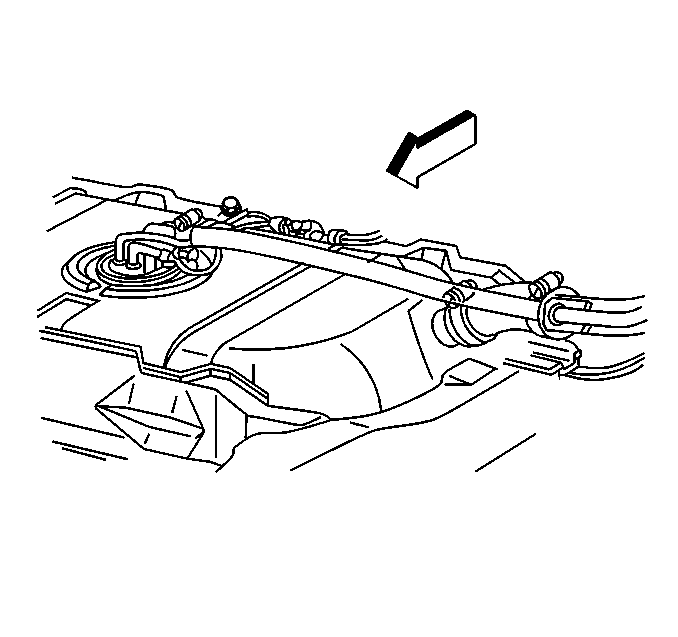
- Loosen the filler neck
hose clamp at the fuel tank.
- Disconnect the fuel tank filler neck from the fuel tank.
- Support the fuel tank.
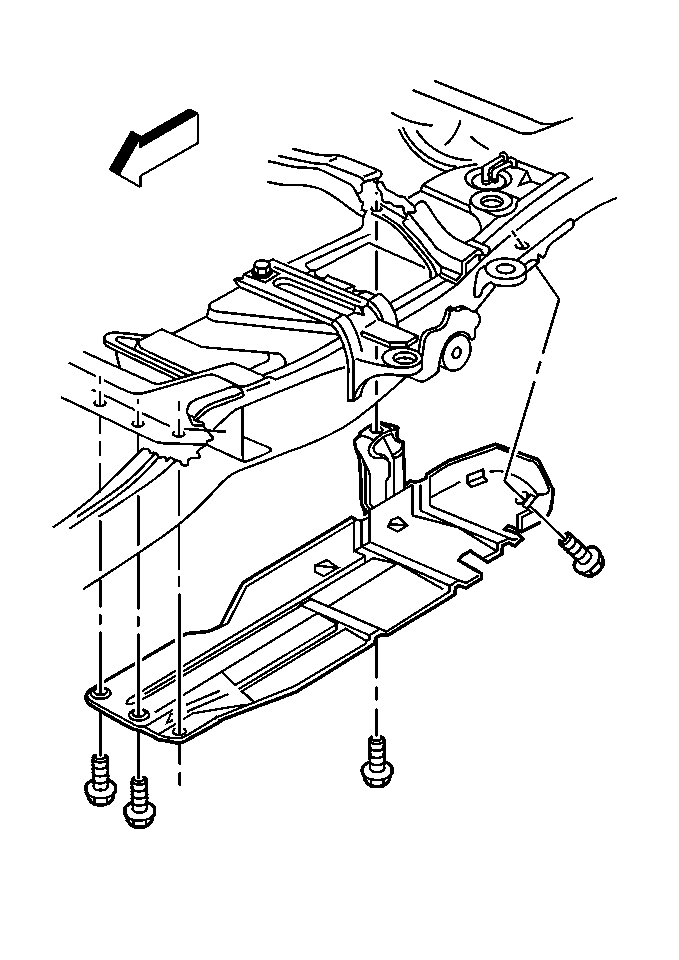
- Remove the fuel tank shield.
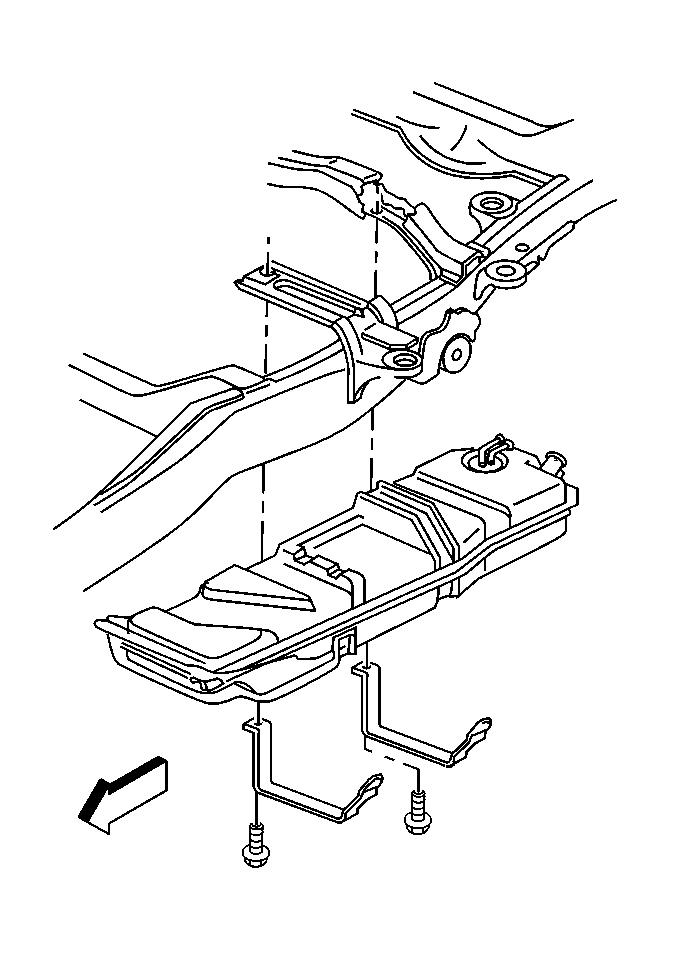
- Remove the tank straps.
Notice: Ensure that the connections to both roll over valves are disconnected
prior to lowering the fuel tank more than 51 mm (2 in). The
roll over valves are located at both the front and rear of the fuel tank.
Notice: Use extreme care when lowering the fuel tank. The fuel sender is made
of plastic. Lowering the fuel tank may damage the fuel sender.
- Lower the fuel tank.

- Disconnect the fuel
and vapor hoses and the electrical connections at the sender.
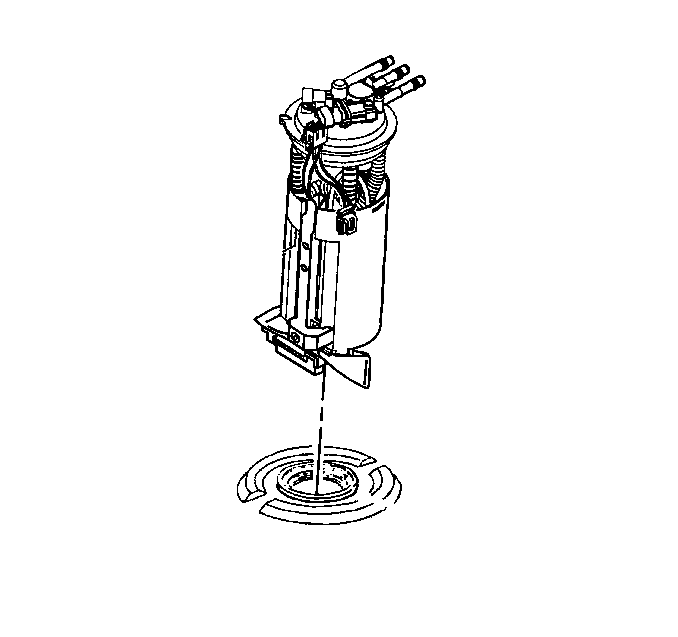
- Use tool J36608
in order to remove the
fuel sender and the seal ring.
- Discard the old seal ring.
- Purge the tank, if being repaired.
Purge Procedure
Important: Gasoline mixed with water and water mixed with an emulsifying agent
needs to be treated as a hazardous material. The material needs to be handled
in accordance with all of the applicable local, state, and federal laws and
regulations.
The fuel tank should be purged before being repaired.
- Remove the fuel tank from the vehicle.
- Remove the fuel gage sending and the pump unit.
- Remove all of the remaining fuel from the tank.
- Inspect the tank for any remaining fuel.
- Pour tap water into the tank.
| • | Move the tank into the flushing area (wash rack). |
| • | Agitate the water vigorously. |
- Pour the gasoline emulsifying agent into the tank. Use an available
emulsifying agent.
- Add water to the fuel tank.
| • | Refer to the emulsifying agent specifications for the mixture
ratio. |
| • | Agitate the mixture for ten minutes. |
| • | Drain the tank completely. |
| • | Fill the tank with water until the tank overflows. |
| • | Completely flush out any remaining mixture. |
| • | Use an explosion meter (if available) in order to check for a
negative reading. |
| • | Perform the required service work. |
- Repair the fuel tank.
Installation Procedure
Fuel Tank Purging
- Inspect the tank for any remaining fuel.
- Pour tap water into the tank.
| • | Move the tank to the flushing area (wash rack). |
| • | Agitate the water vigorously. |
- Pour the gasoline emulsifying agent into the tank.
Use an available emulsifying agent.
- Add water to the fuel tank.
| • | Refer to the emulsifying agent specifications for the mixture
ratio. |
| • | Agitate the mixture for ten minutes. |
| • | Drain the tank completely. |
| • | Fill the tank with water until it overflows. |
| • | Completely flush out any remaining mixture. |
| • | Use an explosion meter (if available) in order to check for a
negative reading. |
| • | Perform the required service work. |
- Repair fuel tank.
- Install the fuel gage sending and pump unit.
- Install the fuel tank onto vehicle.
- Check for leaks.
Installation Procedure

- Install a new seal
ring.
Notice: Do not fold or twist the strainer when installing the sending unit.
This action restricts fuel flow.
- Reinstall sender using tool J36608
.
- Raise tank slightly.

- Reconnect the fuel
and vapor hoses and the electrical connections at the sender.
Ensure the ground strap is also reinstalled to the body.
- Raise the tank fully.

- Reinstall the fuel
tank filler neck to the tank.
- Tighten the clamp.

Notice: Tighten the strap fasteners by steps, alternating between the fasteners,
until the specified torque is reached. A failure to tighten the strap fasteners
as specified will cause the bottom of the tank to flex upward. This will result
in the fuel gauge indicating that there is fuel remaining in the tank when
the tank is empty.
- Install the fuel tank brackets with insulator strips in place.
Tighten
Tighten the strap nuts to 45 N·m (33 lb ft.).
Notice: Use the correct fastener in the correct location. Replacement fasteners
must be the correct part number for that application. Fasteners requiring
replacement or fasteners requiring the use of thread locking compound or sealant
are identified in the service procedure. Do not use paints, lubricants, or
corrosion inhibitors on fasteners or fastener joint surfaces unless specified.
These coatings affect fastener torque and joint clamping force and may damage
the fastener. Use the correct tightening sequence and specifications when
installing fasteners in order to avoid damage to parts and systems.

- Install the fuel tank shield
- Lower the vehicle.
- Replenish fuel.
- Reinstall fuel tank filler cap.
- Reconnect the negative battery cable.
If a memory retention device was not used, please reset (to the extent
possible) all devices that lost their memory after the battery was disconnected.
- Check for leaks.
Fuel Tank Replacement 2 Door Utility
Draining Procedure
Caution: Gasoline or gasoline vapors are highly flammable. A fire could occur
if an ignition source is present. Never drain or store gasoline or diesel
fuel in an open container, due to the possibility of fire or explosion. Have
a dry chemical (Class B) fire extinguisher nearby.
Caution: Unless directed otherwise, the ignition and start switch must be in the OFF or LOCK position, and all electrical loads must be OFF before servicing
any electrical component. Disconnect the negative battery cable to prevent an electrical spark should a tool or equipment come in contact with an exposed electrical terminal. Failure to follow these precautions may result in personal injury and/or damage to
the vehicle or its components.
- Disconnect the negative
battery cable.
- Use a hand operated pump device in order to remove the fuel through
the filler neck.
If the pump is equipped, make sure to hook up the static ground wire
to a metal part of the gas tank before you begin.
Removal Procedure
- Raise the vehicle. Refer to
Notice: When jacking or lifting a vehicle, do not allow the lift pads to contact any
of the following parts:
| • | The catalytic converter |
| • | The transmission shift cables |
in General Information.

- Loosen the filler neck
hose clamp at the fuel tank.
- Disconnect the fuel tank filler neck from the fuel tank.
- Support the fuel tank.
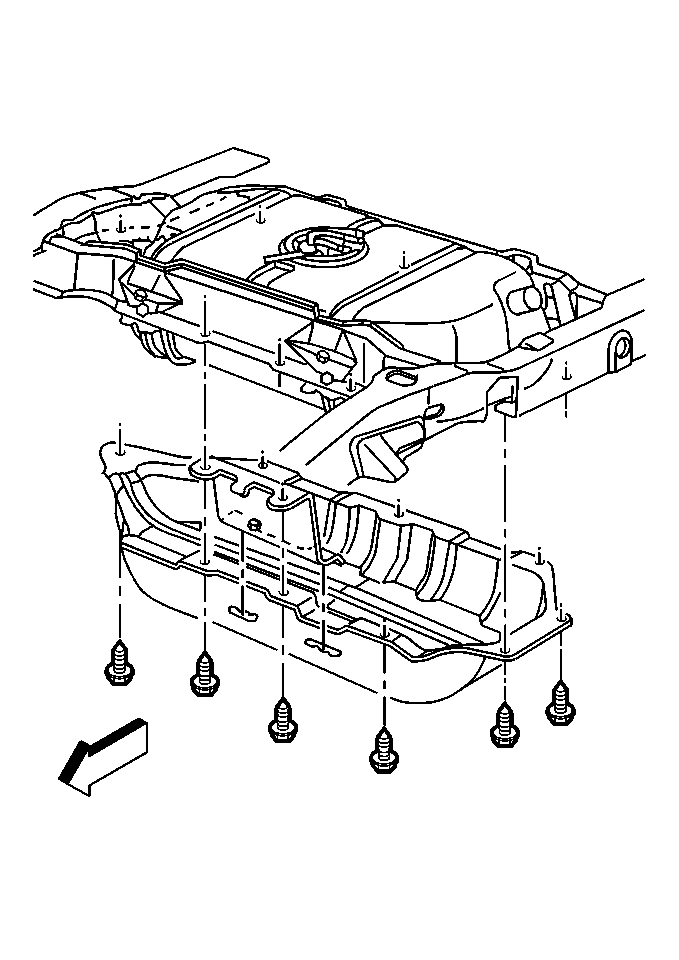
- Remove the fuel tank shield.

- Remove the tank straps.
Notice: Ensure that the connections to both roll over valves are disconnected
prior to lowering the fuel tank more than 51 mm (2 in). The
roll over valves are located at both the front and rear of the fuel tank.
Notice: Use extreme care when lowering the fuel tank. The fuel sender is made
of plastic. Lowering the fuel tank may damage the fuel sender.
- Lower the fuel tank.

- Disconnect the fuel
and vapor hoses and the electrical connections at the sender.

- Use tool J36608
in order to remove the
fuel sender and seal ring.
- Discard the old seal ring.
- Purge the tank, if being repaired.
Purge Procedure
Important: Gasoline mixed with water and water mixed with an emulsifying agent
needs to be treated as a hazardous material. The material needs to be handled
in accordance with all of the applicable local, state, and federal laws and
regulations.
The fuel tank should be purged before being repaired.
- Remove the fuel tank from the vehicle.
- Remove the fuel gage sending and the pump unit.
- Remove all of the remaining fuel from the tank.
- Inspect the tank for any remaining fuel.
- Pour tap water into the tank.
| • | Move the tank into the flushing area (wash rack). |
| • | Agitate the water vigorously. |
- Pour the gasoline emulsifying agent into the tank. Use an available
emulsifying agent.
- Add water to the fuel tank.
| • | Refer to the emulsifying agent specifications for the mixture
ratio. |
| • | Agitate the mixture for ten minutes. |
| • | Drain the tank completely. |
| • | Fill the tank with water until the tank overflows. |
| • | Completely flush out any remaining mixture. |
| • | Use an explosion meter (if available) in order to check for a
negative reading. |
| • | Perform the required service work. |
- Repair the fuel tank.
Installation Procedure
Fuel Tank Purging
- Inspect the tank for any remaining fuel.
- Pour tap water into the tank.
| • | Move the tank to the flushing area (wash rack). |
| • | Agitate the water vigorously. |
- Pour the gasoline emulsifying agent into the tank.
Use an available emulsifying agent.
- Add water to the fuel tank.
| • | Refer to the emulsifying agent specifications for the mixture
ratio. |
| • | Agitate the mixture for ten minutes. |
| • | Drain the tank completely. |
| • | Fill the tank with water until it overflows. |
| • | Completely flush out any remaining mixture. |
| • | Use an explosion meter (if available) in order to check for a
negative reading. |
| • | Perform the required service work. |
- Repair fuel tank.
- Install the fuel gage sending and pump unit.
- Install the fuel tank onto vehicle.
- Check for leaks.
Installation Procedure

- Install a new
seal ring.
Notice: Do not fold or twist the strainer when installing the sending unit.
This action restricts fuel flow.
- Use tool J36608 in order to install the fuel gage sending and pump unit.
- Raise the tank slightly.
- Connect the fuel lines to the top of the sending unit.

- Reconnect the fuel
and vapor hoses and the electrical connections at the sender.
Ensure the ground strap is also reinstalled to the body.
- Raise the tank fully.

- Reinstall the fuel
tank filler neck to the tank.
- Tighten the clamp.

Notice: Tighten the strap fasteners by steps, alternating between the fasteners,
until the specified torque is reached. A failure to tighten the strap fasteners
as specified will cause the bottom of the tank to flex upward. This will result
in the fuel gauge indicating that there is fuel remaining in the tank when
the tank is empty.
- Install the fuel tank brackets with insulator strips in place.
Tighten
Tighten the strap nuts to 45 N·m (33 lb ft).
Notice: Use the correct fastener in the correct location. Replacement fasteners
must be the correct part number for that application. Fasteners requiring
replacement or fasteners requiring the use of thread locking compound or sealant
are identified in the service procedure. Do not use paints, lubricants, or
corrosion inhibitors on fasteners or fastener joint surfaces unless specified.
These coatings affect fastener torque and joint clamping force and may damage
the fastener. Use the correct tightening sequence and specifications when
installing fasteners in order to avoid damage to parts and systems.

- Install the fuel tank shield
- Lower the vehicle.
- Replenish the fuel.
- Reinstall the fuel tank filler cap.
- Reconnect the negative battery cable.
If a memory retention device was not used, please reset (to the extent
possible) all devices that lost their memory after the battery was disconnected.
- Check for leaks.




















